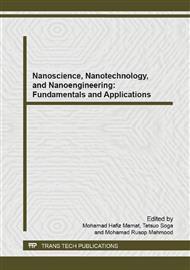[1]
H. Morikawa, H. Kikuchi, and N. Saito, "Development and Advances of a V-Flow FC Stack for FCX Clarity," SAE International2009.
DOI: 10.4271/2009-01-1010
Google Scholar
[2]
G. Zhang and S. G. Kandlikar, "A critical review of cooling techniques in proton exchange membrane fuel cell stacks," international journal of hydrogen energy, vol. 37, pp.2412-2429, 2012.
DOI: 10.1016/j.ijhydene.2011.11.010
Google Scholar
[3]
R. Saidur, K. Y. Leong, and H. A. Mohammad, "A review on applications and challenges of nanofluids," Renewable and Sustainable Energy Reviews, vol. 15, pp.1646-1668, 2011.
DOI: 10.1016/j.rser.2010.11.035
Google Scholar
[4]
Y. Wang, K. S. Chen, J. Mishler, S. C. Cho, and X. C. Adroher, "A review of polymer electrolyte membrane fuel cells: Technology, applications, and needs on fundamental research," Applied Energy, vol. 88, pp.981-1007, 2011.
DOI: 10.1016/j.apenergy.2010.09.030
Google Scholar
[5]
A. Faghi and Z. Guo, "Challenges and opportunities of thermal management issues related to fuel cell technology and modeling," International Journal of Heat and Mass Transfer, vol. 48, pp.3891-3920, 2005.
DOI: 10.1016/j.ijheatmasstransfer.2005.04.014
Google Scholar
[6]
E. Hosseinzadeh, M. Rokni, A. Rabbani, and H. H. Mortensen, "Thermal and water management of low temperature Proton Exchange Membrane Fuel Cell in fork-lift truck power system," Applied Energy, vol. 104, pp.434-444, 2013.
DOI: 10.1016/j.apenergy.2012.11.048
Google Scholar
[7]
G. Cengel, Heat and Mass Transfer : Fundamentals and Application, 4th ed.: Mc Graw hills companies, 2011.
Google Scholar
[8]
A. V. G. carol S.Jeffcoat, Peter M.Woyciesjes,Filipe J.Marinho., "Heat Transfer Compositions With High Electrical Resistance For Fuel Cell Assemblies," United states Patent, 2009.
Google Scholar
[9]
P. McMullen, S. Mohapatra, and E. Donovan. Advances in PEM Fuel Cell Nano-Coolant [Online].
Google Scholar
[10]
S. C.Mohapatra, "fuel cell and fuel cell coolant compositions," united state of america Patent 7,138,199, 2006.
Google Scholar
[11]
T. Takashiba and S. Yagawa, "Development of fuel cell coolant," Honda R&D C0.Ltd2009.
Google Scholar
[12]
W. Yu and H. Xie, "A Review on Nanofluids: Preparation, Stability Mechanisms,and Applications," Journal of Nanomaterials, vol. 2012, 2011.
Google Scholar
[13]
K. G. K. Sarojini, S. V. Manoj, P. K. Singh, T. Pradeep, and S. K. Das, "Electrical conductivity of ceramic and metallic nanofluids," Colloids and Surfaces A: Physicochemical and Engineering Aspects, vol. 417, pp.39-46, 2013.
DOI: 10.1016/j.colsurfa.2012.10.010
Google Scholar
[14]
R. S. L. Alina Adriana Minea, "Investigations on electrical conductivity of stabilized water based Al2O3 nanofluids," Microfluid Nanofluid, vol. 13, 2012.
DOI: 10.1007/s10404-012-1017-4
Google Scholar
[15]
K.-F. VincentWong and T. Kurma, "Transport properties of alumina nanofluids," Nanotechnology vol. 19, 2008.
Google Scholar
[16]
T. T. Baby and S. Ramaprabhu, "Investigation of thermal and electrical conductivity of graphene based nanofluids," Journal of Applied Physics, vol. 108, 2010.
DOI: 10.1063/1.3516289
Google Scholar
[17]
M. Kole and T. K. Dey, "Investigation of thermal conductivity, viscosity, and electrical conductivity of graphene based nanofluids," Journal of Applied Physics, vol. 113, 2013.
DOI: 10.1063/1.4793581
Google Scholar
[18]
S. Ganguly, S. Sikdar, and S. Basu, "Experimental investigation of the effective electrical conductivity of aluminum oxide nanofluids," Powder Technology, vol. 196, pp.326-330, 2009.
DOI: 10.1016/j.powtec.2009.08.010
Google Scholar


